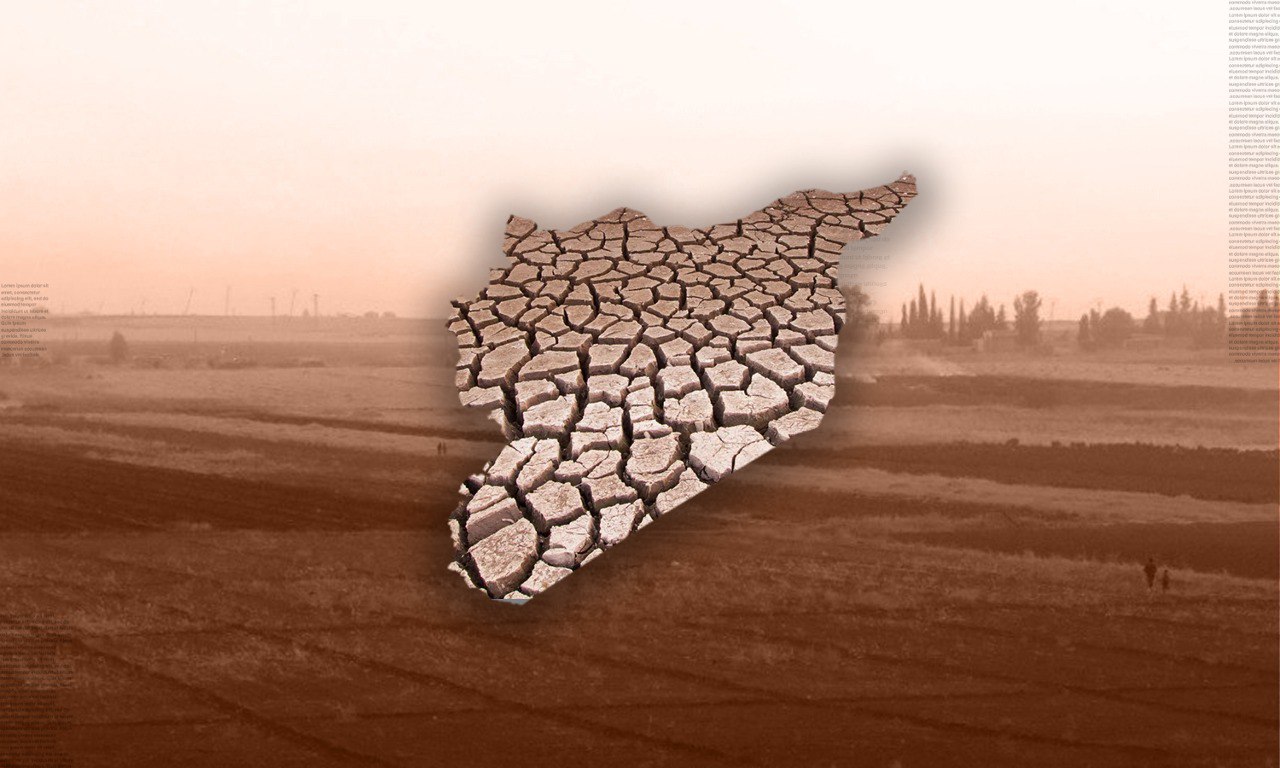



Enab Baladi – Hassan Ibrahim
With despair over what has become of his desolate land, farmer Majd Issam from the village of Haroubi, west of Ras al-Ain, describes the drought and declining groundwater over the past years. He laments the exacerbation of his plight with the high costs of drilling wells, which can surpass $25,000 (about 400 million Syrian pounds), of which he has nothing.
Issam recalls the abundant yield of his land in 2010, which ranged between 400 and 600 kilograms of wheat per dunum when the water level was good, reaching groundwater at a depth of 150 meters, and fuel was available at low prices.
For years, the farmer has relied on rainwater to irrigate his 80-dunum land due to dwindling groundwater. This strained the soil, reduced water access, and turned it from fertile to dry and desert-like, with current yields not exceeding 50 kilograms per dunum.
To reach groundwater, Issam needs to drill a well 500 meters deep at a cost of $30,000, with the possibility of failure. He tells Enab Baladi that agricultural lands need comprehensive reclamation to improve soil structure and restore fertility.
Issam’s land is one of the agricultural areas affected by desertification in Ras al-Ain, northwest of al-Hasakah, and Tel Abyad, north of Raqqa. Other lands have also been hit by sinkholes and collapses, exacerbated by economic factors such as high reclamation and water extraction costs, coupled with human factors like groundwater depletion, neglect by responsible authorities, and marginalization of soil, farmers, and crops.
Over the years, rain-fed areas have surpassed irrigated ones in Tel Abyad and Ras al-Ain, where residents rely on agriculture as their primary income source. The soil has worsened due to excessive groundwater depletion, unsustainable farming practices, poor water resource management, and the drying up of many private wells. Agriculture has turned into a loss-making profession.
Exclusive figures obtained by Enab Baladi indicate that agricultural land in Ras al-Ain covers 1.27 million dunums, with only 200,000 dunums cultivated. The rain-fed areas cover more than 420,000 dunums and have become desertified due to water level drops, producing little to no yield.
The agricultural land in Tel Abyad covers 1.19 million dunums, with 310,000 dunums of irrigated cultivated land, while the rain-fed cultivated areas span 431,000 dunums.
In addition to the vast desertified lands, the region suffers from high farming costs and “marginalization” by the Syrian Interim Government (SIG) towards the agricultural wealth, warn farmers interviewed by Enab Baladi, threatening the collapse of the agricultural sector due to natural and human factors without solutions in sight.
Ras al-Ain and Tel Abyad are located along the Turkish border and have been controlled by the Turkish-backed Syrian National Army (SNA) since 2019. They are surrounded by battlefronts with the Syrian Democratic Forces (SDF) and the Turkish border is their only gateway to the outside.
Desertification means land degradation in arid, semi-arid, and dry sub-humid areas due to various factors, including climatic changes and human activities, according to the United Nations Convention to Combat Desertification in 1994.
Desertification does not only mean the expansion and increase of deserts but is a comprehensive term for the degradation of lands experiencing water scarcity, including temporary or permanent declines in soil quality, vegetation cover, water resources, wildlife, and the economic productivity of the land.
Agricultural engineer in Ras al-Ain, Mohammad Karam, told Enab Baladi that desertification in Ras al-Ain and Tel Abyad has become one of the most prominent environmental issues facing farmland. He explained that the causes are multiple and complex, involving both natural and human factors.
Climate change is a major factor, leading to changes in temperature and rainfall patterns, which dry out the soil and reduce its fertility, significantly impacting agricultural output.
Karam cited excessive groundwater depletion due to unsustainable farming, poor water resource management, and the drying of many private wells as significant contributors to land deterioration.
Human activities, like deforestation and overgrazing, have greatly worsened the situation. The absence of sustainable agricultural policies, lack of farmer awareness and training on modern farming practices, and insufficient support for farmers have exacerbated desertification.
The war and conflicts in the region have intensified the problem by destroying agricultural infrastructure. Population displacement and abandonment of farming have led to neglected agricultural lands, gradually losing their productivity.
The agricultural engineer called for urgent actions to combat desertification, such as adopting sustainable farming strategies, improving water resource management, and raising awareness among farmers about soil and natural resource conservation to ensure sustainable agricultural production.
A source in the Tel Abyad Agriculture Office (requested anonymity as they are not authorized to speak to the media) told Enab Baladi that desertification is the primary issue affecting soil due to scarce irrigation resources, leading to reduced soil fertility, compounded by the high cost of fertilizers.
Farmers in Tel Abyad rely on three main water sources for irrigation: the Jalab River, the Karamokh River, and artesian wells.
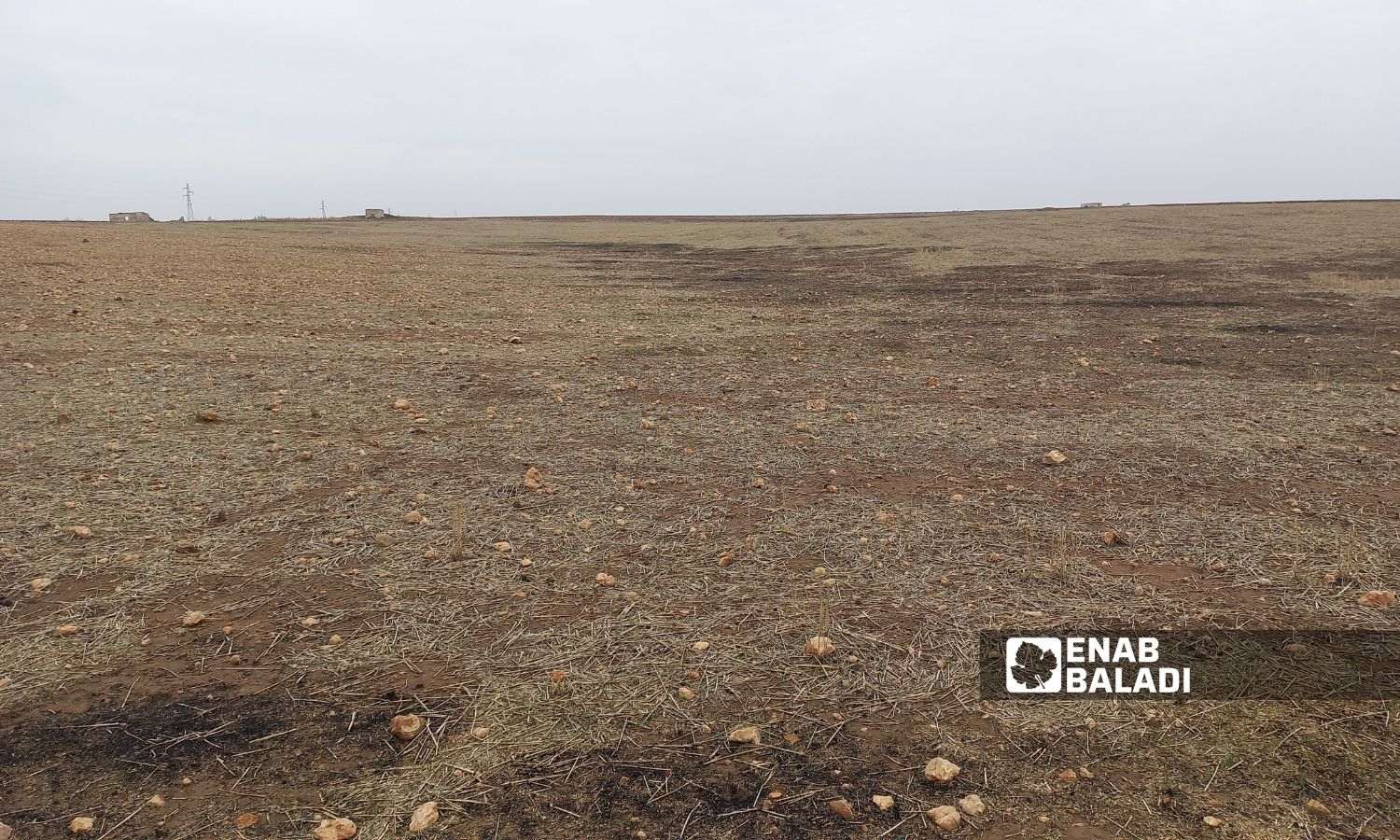
Thousands of dunums in Ras al-Ain have turned from irrigated to dry rain-fed land – December 2023 (Enab Baladi)
In addition to desertification, farmers in Ras al-Ain are forced to irrigate their lands near the Turkish border with polluted water mixed with sewage, coming from the Kheshto, Tel Halaf, and Ain al-Zarqa villages. This water flows from the Khabur River originating from the Turkish city of Ceylanpınar.
On both sides of the river, engines and pumps draw water from the stream and form ponds, irrigating the lands despite the clear contamination from sewage.
Sewage water is not new to the area, having flowed even before 2011 when the Syrian regime controlled it. Farmers used to rely on artesian wells operated by the Water Corporation then, making the Khabur River’s water non-stagnant.
The cessation of artesian well operation and the high cost of fuel have pushed farmers to use Turkish sewage water, contaminating agricultural crops and causing financial losses.
According to a report by Enab Baladi in December 2023, the area of land irrigated with sewage on the Khabur Riverbanks was 1500 dunums.
In July 2024, the official spokesperson for Ras al-Ain Local Council, Ziad Maliki, stated that the area of sewage-irrigated land on the Khabur riverbanks had decreased to 400 dunums.
Maliki explained that the sewage water is very minimal during this period due to high temperatures, causing it to dry up before reaching Syrian lands.
The council conducts regular disinfection of all water wells in Ras al-Ain using chlorine and provides this substance to villagers for disinfecting their water tanks.
Due to the disinfection process on both sides of the Khabur River, farmers grow non-food crops, mainly cotton and alfalfa, according to Maliki.
At the beginning of 2024, sinkholes appeared in Ras al-Ain farmlands along both sides of the Khabur River. The decrease in previous water levels resulted in air gaps (sinkholes), without any supervision, increasing the risk of sewage mixing with drinking water.
The number of sinkholes reached seven, requiring heavy machinery and materials unavailable in Ras al-Ain to close them, along with medical warnings about the dangers of sewage mixing with groundwater, warning against land degradation and unsuitability for farming.
Ras al-Ain Local Council spokesperson Ziad Maliki told Enab Baladi that the council closed most sinkholes along the Khabur Riverbank.
Despite closing the sinkholes, the likelihood of their recurrence remains because they first appeared in early 1976 due to water reduction and the drying of some springs, previously numbering around 365, according to a 2017 interview with Enab Baladi with engineer Juan Abdulaziz when the Autonomous Administration of North and East Syria (AANES) controlled Ras al-Ain.
Abdulaziz said that the most common sinkhole areas were the old watercourse road, churches’ street, Martyr Berivan Park, Sirob Park, and Asayish Academy.
He noted that the city’s geological layer is karst limestone, which needs water for solidity. “When the stones are not saturated with water, they deteriorate (disintegrate), but when they are saturated, they harden.” He attributed water drying to the many underground dams built on the Turkish side, stopping water flow and drying springs.
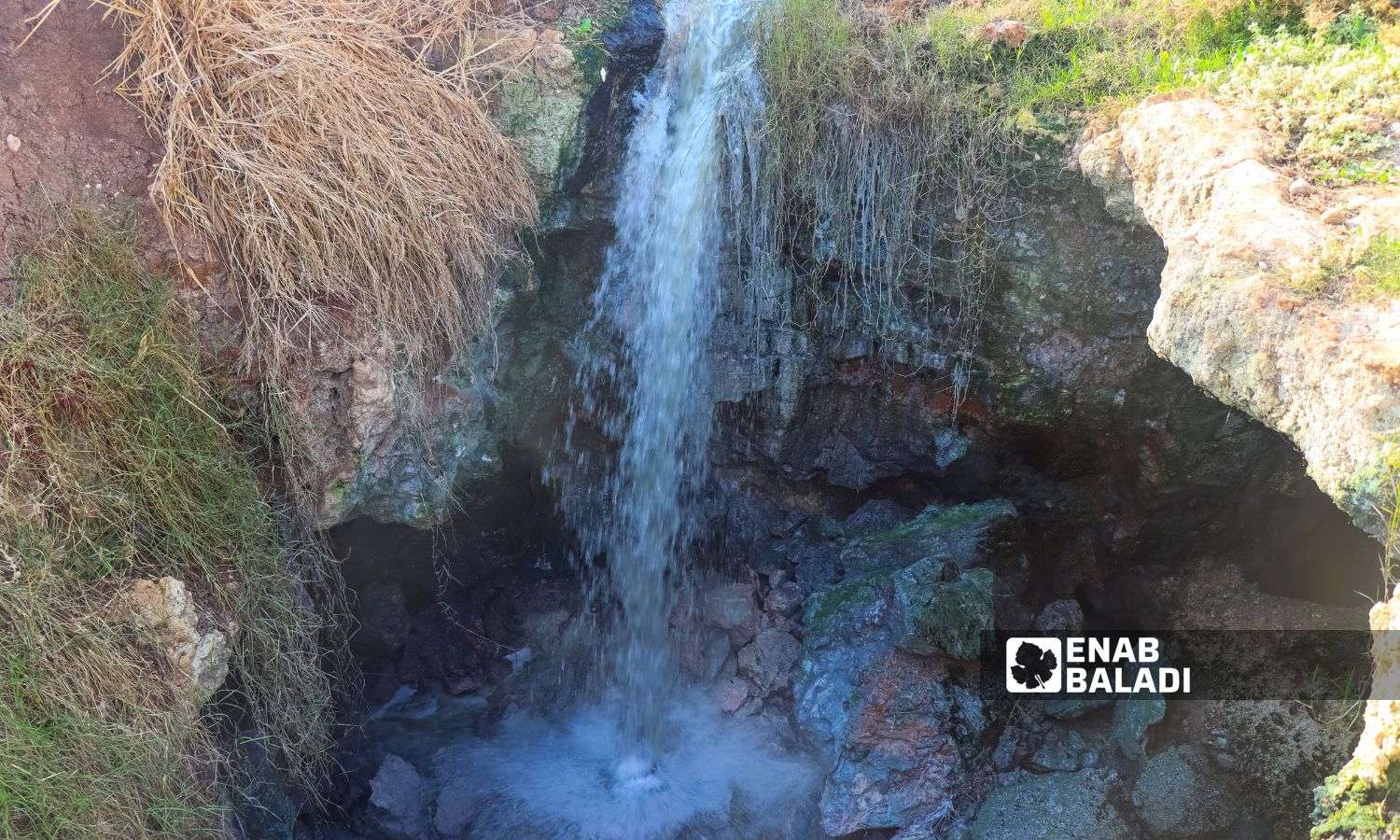
Sewage water enters air gaps in Ras al-Ain lands, northwest of al-Hasakah – January 11, 2024 (Enab Baladi)
Enab Baladi posed questions to the Minister of Agriculture in the Syrian Interim Government (SIG), Engineer Hayil al-Kalash, about the ministry’s role in addressing desertification and soil degradation in Ras al-Ain and Tel Abyad. He referred the issue to agricultural directorates under local councils in those areas.
A source in the Ras al-Ain Agriculture Office (requested anonymity to avoid conflict with the Interim Government) told Enab Baladi that the local council focuses on supporting the agricultural sector by providing guidance and machinery at nominal fees affordable to residents.
Regarding desertification, the source said that the local council faces challenges in reclaiming land without government and organizational support. Reclaiming these lands requires drilling hundreds of agricultural wells to improve soil quality, which the local council cannot achieve at present.
The source added that the Agriculture Directorate’s capabilities are limited to conducting surveys and presenting them to organizations and the Interim Government, besides supporting livestock and agriculture within its capacity.

Thousands of dunums turned from irrigated to dry rain-fed land in Ras al-Ain – December 2023 (Enab Baladi)
Source: United Nations
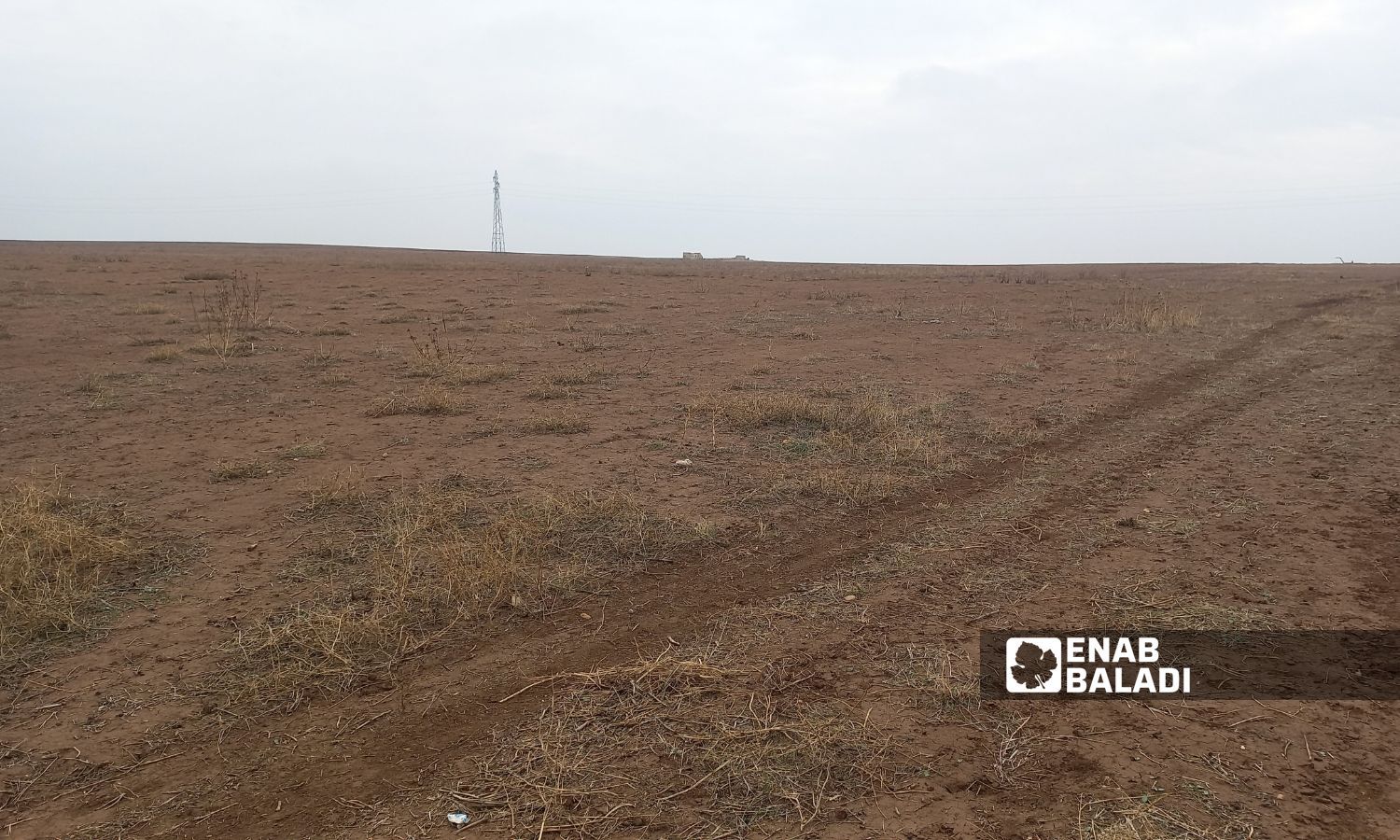
Thousands of dunums turned from irrigated to dry rain-fed land in Ras al-Ain – December 2023 (Enab Baladi)
Soil deterioration, declining groundwater, and financial losses in farming seasons have pushed residents in Ras al-Ain and Tel Abyad to sell their agricultural lands, either partially or wholly, to repay accumulated debts.
“When desertification happens, people go hungry, leave their lands, and must find other places to make a living,” said soil scientist Jeff Herrick, from the US Agricultural Research Service and US scientific delegate to the United Nations Convention to Combat Desertification. This statement has become true for farmers in Tel Abyad and Ras al-Ain.
According to locals interviewed by Enab Baladi, this direction was not a choice but has become an inevitable fate in a region where inhabitants rely on agriculture as a primary income source. Land productivity has declined due to weakened soil structure and desertification, crop prices have fallen, and market opportunities have become limited. This is while traders control prices, and the Interim Government refrains from purchasing most of the produce.
Agricultural lands in Ras al-Ain are divided into four stability zones based on water availability and rainfall amounts in each area:
The first stability zone covers the eastern countryside.
The second includes the southwestern countryside.
The third encompasses the southeastern countryside.
The fourth zone is along the international M4 highway, which separates opposition-held areas and SDF-controlled areas west of Ras al-Ain.
As selling increased, prices have variably dropped compared to the actual land value. For example, the irrigated dunum in the eastern countryside costs $1,000, but the current selling price is $750 per dunum.
In the southwestern countryside (second stability zone), where water is scarcer, the irrigated dunum costs $650, but the selling price currently ranges between $450 and $500 per dunum. In the southeastern countryside (third stability zone), the dunum costs $400, and sells for between $300 and $350 at most.
For the western countryside (fourth stability zone), there’s no active land buying or selling due to desertification and water scarcity, and a dunum doesn’t exceed $150.
One US dollar equals 15,200 Syrian pounds or 33.3 Turkish lira.
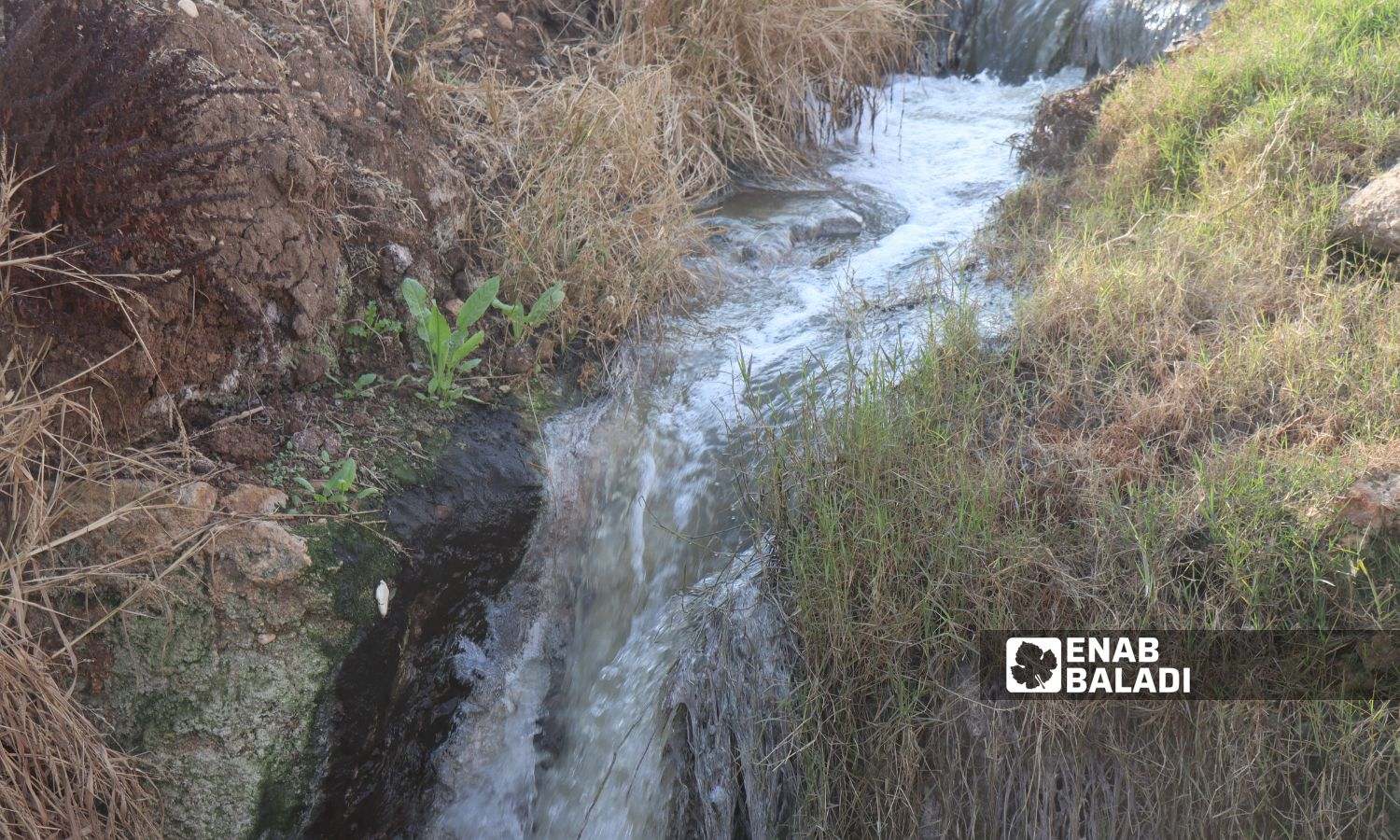
Sewage water enters air gaps in Ras al-Ain lands, northwest of al-Hasakah – January 11, 2024 (Enab Baladi)
Malek al-Hassan, residing in the village of Alouk east of Ras al-Ain, said poor farming seasons, low production, and accumulated debts forced him to sell about 25 dunums out of his total 50 dunums of agricultural land.
He told Enab Baladi that he sold each dunum for $550, considering it a low price in the first stability zone. He noted that his total debts exceeded $13,000 due to purchasing agricultural materials, fertilizers, and seeds for preparing the land, with low returns due to falling crop prices.
Meanwhile, Hamoudi al-Qurait from the village of Qusayr in the southwestern countryside (second stability zone), told Enab Baladi that he was forced to sell his 35 dunums for less than their actual value, at $450 per dunum, due to agricultural losses over the past four years.
He explained that this land was the hope for improving his income and providing a decent life for his family, but the circumstances were not in his favor, leading to unbearable debt accumulation.
After selling his land, al-Qurait hopes to secure his family’s needs by turning to the second-hand clothing trade.
Abdullah al-Jaber owns agricultural land in the village of Tel Omar west of Ras al-Ain, adjacent to the international M4 highway, acting as the dividing line between areas controlled by the Syrian National Army and the SDF. This area falls under what is locally called the fourth zone, suffering from desertification and irrigation water scarcity and depends only on rainfall.
Al-Jaber told Enab Baladi that although this year witnessed plentiful rainfall, the weak agricultural season of durum wheat, alongside the Interim Government’s refusal to buy his crop and traders’ reluctance to purchase durum wheat, led to debt accumulation.
He added that he tried selling his agricultural land in this area, but nobody came forward to buy it due to water scarcity and their refusal to pay $100 per dunum.
He pointed out that he is currently seeking to migrate to Turkey illegally to pay off his debts, which exceed $6,000.
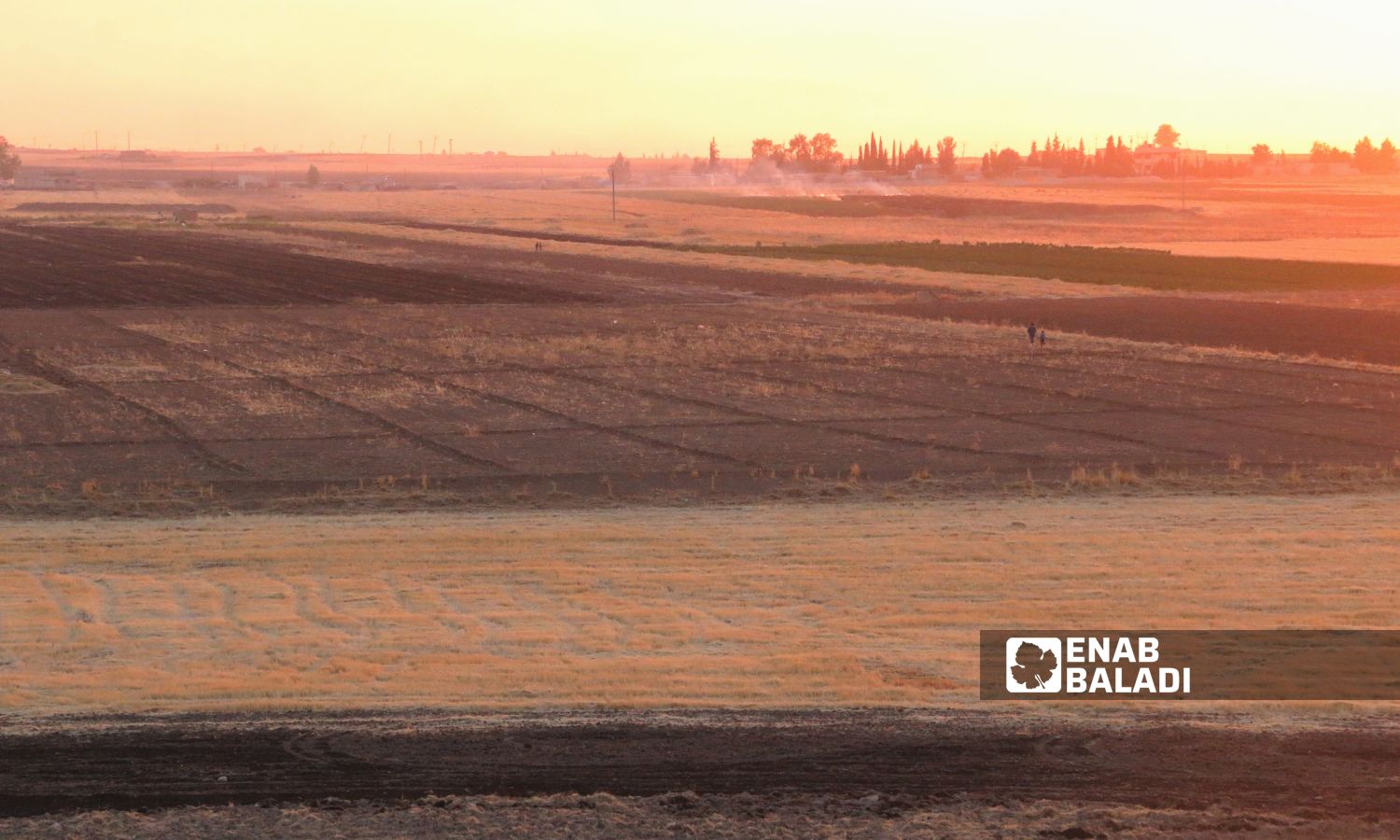
Thousands of dunums turned from irrigated to dry rain-fed land in Ras al-Ain – June 24, 2024 (Enab Baladi)
Omar Hamoud, head of the Agriculture Office in the local council, told Enab Baladi that the total agricultural land area in Ras al-Ain is 1,270,000 dunums, of which only 200,000 dunums are cultivated.
Fawaz al-Qurani, a real estate office owner in Ras al-Ain, told Enab Baladi that over the past two years, more than 7,500 dunums have been listed for sale in the area.
He explained that he has been in this business for more than 25 years but has not witnessed such significant demand for selling agricultural land, primarily due to lack of support, weak agricultural production, and poor crop marketing.
Al-Qurani described the current land buying and selling activity as moderate, as most buyers are expatriates in Gulf countries or Europe. Contracts are organized between them in real estate offices.
He noted that lands are sold below their actual value in the area due to farmers’ urgent need to pay off debts, including plowing costs and solar energy and fertilizer systems.
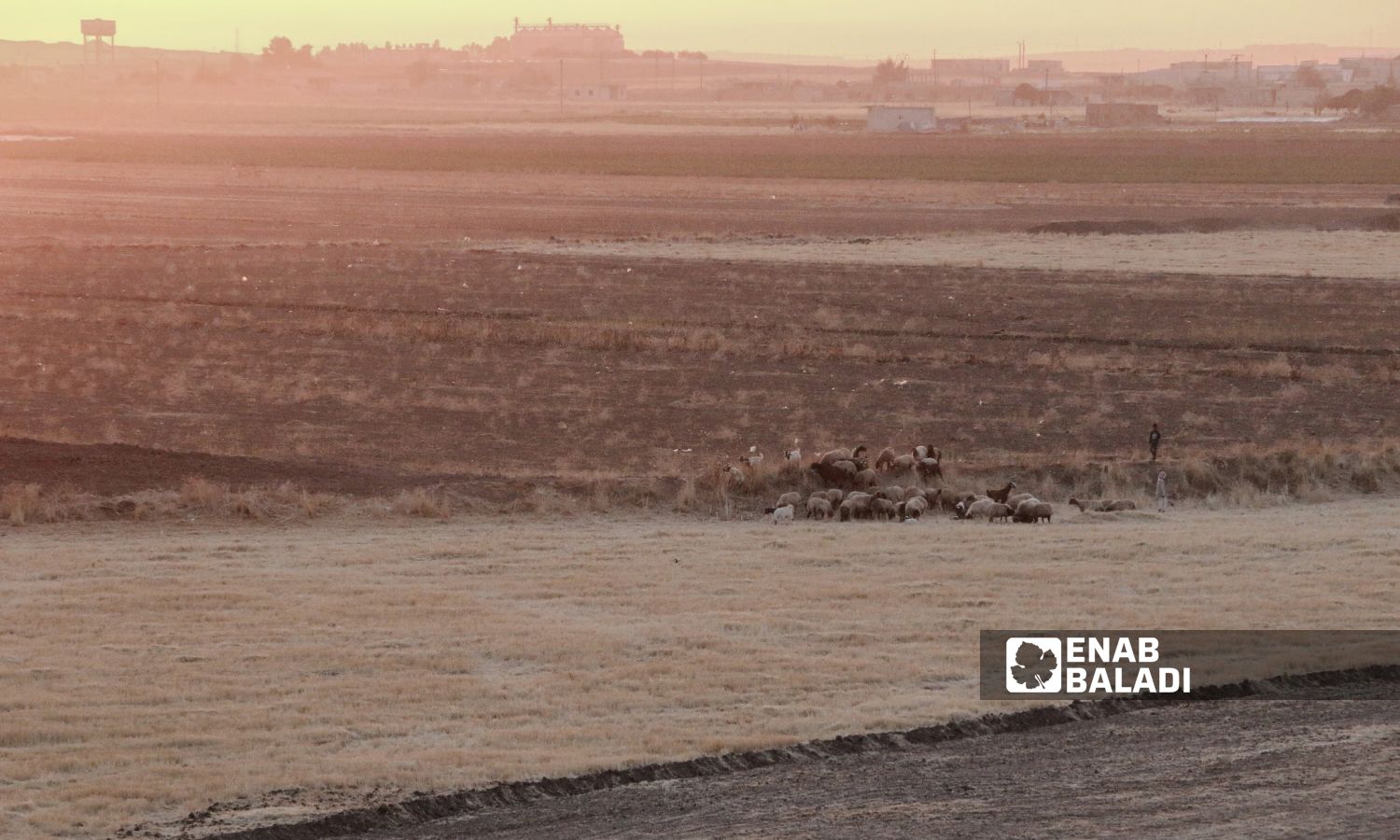
Thousands of dunums turned from irrigated to dry rain-fed land in Ras al-Ain – June 24, 2024 (Enab Baladi)
Ali al-Malek, a real estate store owner in the city of Tel Abyad, said that the movement of buying and selling agricultural lands in Tel Abyad is less compared to its neighbor, Ras al-Ain, which is known for higher soil fertility and cultivability.
He explained to Enab Baladi that the price of agricultural lands in Tel Abyad largely depends on the availability of water in the area. He added that the price of irrigated dunum ranges from 650 to 800 US dollars, while the prices of rainfed lands range between 150 and 250 US dollars per dunum, depending on the quality of the soil and its suitability for cultivation.
He indicated that the buying and selling movement of agricultural lands in Tel Abyad is not significant, as some lands suffer from desertification and low water levels, which makes them less attractive for buyers.
Returning to the concept of desertification caused by several factors, climate change interacts with other human causes of soil degradation, such as unsustainable land management, leading to or exacerbating desertification.
The succession of controlling parties over Tel Abyad and Ras al-Ain has contributed to enhancing desertification due to lack of support for farmers, leaving their crops at unfitting prices, the absence of solutions for product marketing, and leaving farmers as “victims” facing traders. Additionally, economic factors have worn down agricultural production, leaving their mark on the land and its fertility.
The control of the Syrian regime over the two cities ended in 2012, with the former Free Syrian Army (FSA) taking over. In 2013, the Syrian Democratic Forces (SDF) took control until 2019 (initially known as the Kurdish forces), and then the Syrian National Army, backed by Turkish forces, took control during Operation “Peace Spring.”
A farmer in his sixties from Ras al-Ain, who witnessed all the control shifts, talked to Enab Baladi about the agricultural situation in the area. He said he saw clear economic growth and improvement from 1993 to 2010, with the common seasons being wheat and cotton.
The farmer, who requested anonymity for safety reasons, explained that during the regime’s control, there was an agricultural bank in Ras al-Ain and Tel Abyad, which provided fertilizers to farmers on credit until the harvest season, in exchange for a small profit margin from the farmer.
He mentioned that wheat production ranged between 600 to 700 kilos per dunum, and the ton was sold to the Grains Institution for 23,000 Syrian pounds, equivalent to about 500 dollars at the time. The Seed Multiplication Establishment provided incentives to contracted farmers at 30% for the wheat season.
A former source at the Grains Institution in al-Hasakah explained to Enab Baladi that wheat production in the area ranged between 400 to 600 kilos per dunum from 1993 to 2012, with very rare instances reaching 700 kilograms.
As for cotton, the farmer said that the public institution for cotton ginning and marketing was responsible for buying cotton from farmers at a price of 60 Syrian pounds per kilo. Fuel was available at an acceptable and encouraging price for farmers, and this agricultural situation lasted from 1993 to 2010, but the most flourishing days were from 2007 to 2010, according to the farmer.
He added that during the control of Kurdish forces in 2013, agricultural conditions were very poor in the first three years, with no agricultural services or any form of support. However, by 2016, the Autonomous Administration began improving agricultural conditions and providing fuel to farmers through special coupons at a price of 16,000 Syrian pounds, equivalent to about 30 US dollars per barrel (200 liters) at the time.
Also, fertilizers were provided to farmers without any financial interest. Agricultural production during that time was between 350 and 450 kilos for wheat, and the ton was priced at 360 US dollars. After calculating all agricultural costs, 40 US dollars remained from each dunum.
As for cotton, the agricultural situation was good, but the prices of medicines to combat crop diseases were very high, and the percentage of cultivated land was close to 95% due to the availability of fuel and the operation of large engines to draw water from the wells.
After the SDF was ousted from the area by the National Army, the Interim Government did not provide any agricultural support to the area, leading to a significant decline in agricultural seasons, with wheat production ranging between 150 to 300 kilos per dunum at best, exacerbating losses as fuel prices rose to 150 US dollars per barrel (200 liters), according to the elderly farmer.
Most farmers could not install solar energy systems to operate their wells, leading to a reduction in cultivated land areas due to high costs and low wheat and cotton prices in the region.
After calculating agricultural costs for the 2024 wheat season, it was found that their loss per dunum exceeded 25 US dollars, and the same applied to cotton, where the prices of seeds rose, and the quality of imported “transit” fertilizers through crossings declined.
The farmer considered that since its control, the Interim Government has completely neglected agriculture and did not provide any support to farmers, relying on local councils that didn’t have the capacity to support farmers and only made promises.
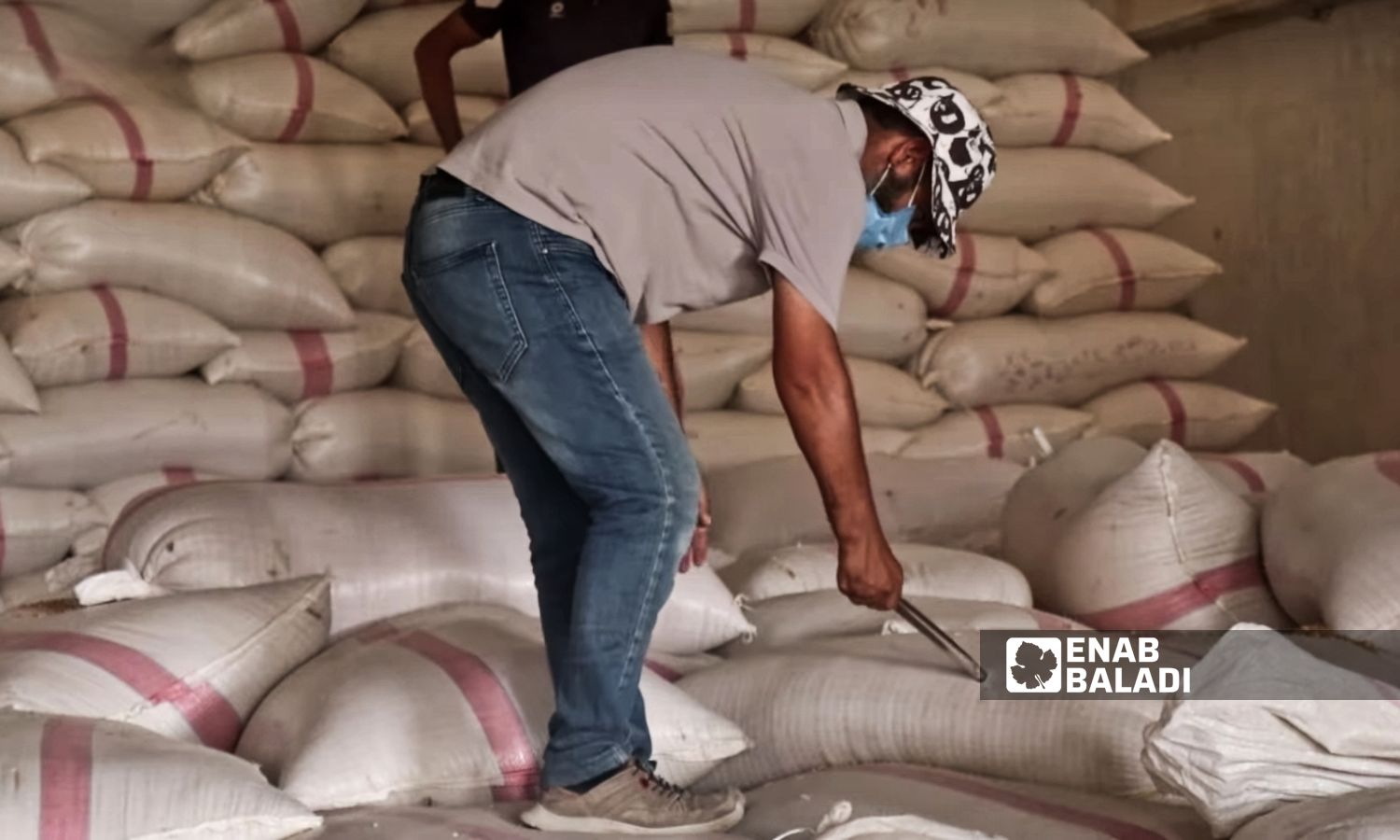
Farmers in Ras al-Ain considered that the Interim Government wastes their crops with the prices it sets – July 27, 2024 (Enab Baladi)
Farmer Sultan al-Khamis, from the Tel Abyad area, suffers from the same problems on his 128 dunum plot, which he plants with typical crops (wheat and cotton) every year.
Al-Khamis told Enab Baladi that over the past five years, he has struggled to secure the essentials for his agricultural land, most importantly the solar energy system which cost him about 15,000 US dollars, in addition to the high prices of seeds and fertilizers, which led to a decline in yields in recent seasons.
He added that the usual crops in Tel Abyad are wheat and cotton, but he had to plant new crops such as cumin, onions, and even watermelon due to the difficulty of marketing the usual agricultural crops.
He indicated that he suffered significant losses during these seasons due to the very high agricultural costs and the difficulty in securing good quality seeds, in addition to traders controlling prices and buying crops at very low prices that do not even cover production costs.
He reminded the Interim Government of its responsibility to support agriculture in the area, as production has declined, forcing some farmers to sell part of their lands to pay off accumulated debts.
According to a report from Enab Baladi in June 2024, the Minister of Economy in the Syrian Interim Government, Abdul Hakim al-Masri, said that the reason for setting the price for purchasing a ton of wheat from farmers at 220 US dollars was due to the government’s lack of financial capability to buy at a price higher than the global market price.
The minister considered that raising the price more would cause a loss to the Grains Institution and raise bread prices in the region, reducing its support due to additional costs such as transporting wheat from Tel Abyad and Ras al-Ain to Aleppo countryside cities.
Al-Masri pointed out that setting a higher price for the product in other controlled areas might be due to higher financial resources available to the authorities, such as taxes and imports, in addition to setting a higher price for bread loaves to ensure they are not sold at cost price, in his opinion.
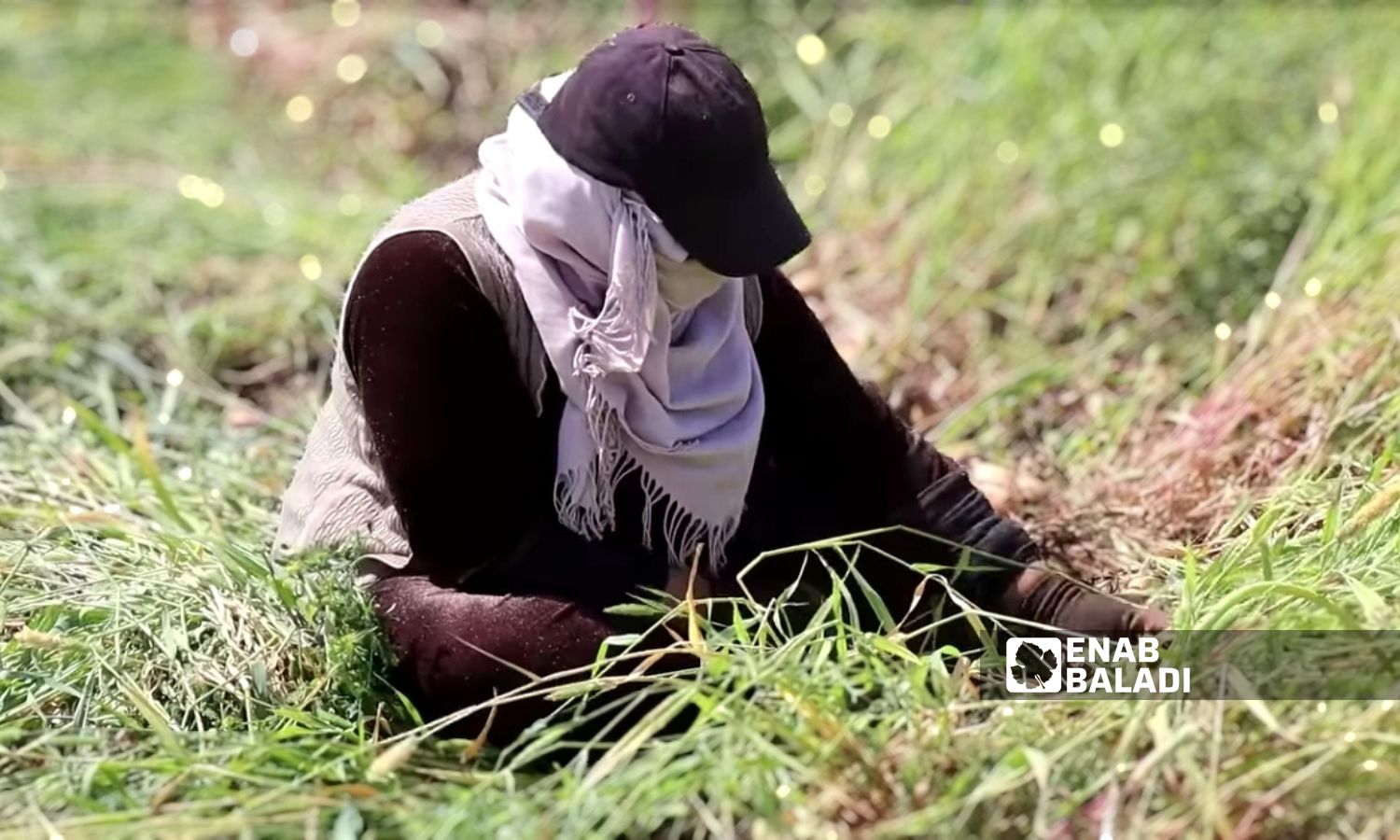
Farmers said that agriculture has become a losing profession in Ras al-Ain – August 5, 2024 (Enab Baladi)
During the wheat harvest season in Ras al-Ain in 2023, farmers complained about their crops piling up as the Syrian Interim Government only received small quantities and set the price for purchasing a ton of supreme hard wheat at 330 US dollars. Despite this set price, farmers could not sell clean hard wheat to traders for more than 220 US dollars per ton, and soft wheat for 150 US dollars per ton.
The Interim Government did not intervene in purchasing the cotton crop in 2023, and the price per ton ranged between 500 and 550 US dollars, while in 2022, it ranged between 750 and 800 dollars.
In September 2023, about 1,430 dunums of watermelon out of the 2000 planted dunums were damaged due to poor seed quality, inability of farmers to buy fertilizers, and medicines to treat diseases that affected the crop.
In May 2024, the cumin crop was damaged due to diseases and late rains, with the damage rate exceeding 65% of the 60,000 dunum planted area, and the price per kilogram of cumin dropped from 12 dollars to three dollars.
In June 2024, the Interim Government set the price for a ton of grade one soft wheat at 220 US dollars, grade two at 215 dollars, and grade three at 210 dollars per ton, without specifying the price for hard wheat.
They added bonuses, which were five dollars on the price per ton in Tel Abyad and Ras al-Ain, making it the lowest price for wheat purchase among the four controlled areas in Syria.
The United Nations proposed several solutions to combat desertification, including reforestation and afforestation, water management through the provision or reuse of treated water, collection of rainwater, desalination, or direct use of seawater for salt-loving plants, and soil stabilization through sand fences, shelterbelts, firewood, and windbreaks.
The DGP organization specializing in ecosystem restoration considered in its report that effectively combating desertification requires a mix of preventative and remedial measures. Implementing sustainable land management practices, reforestation, and afforestation initiatives, as well as effective water conservation and management strategies, could prevent land degradation and improve the resilience of nature and local communities in affected areas.
The organization suggested techniques to restore soil fertility and quality in desertified regions, such as adding organic materials like compost, manure, and crop residues to the soil, using fertilizers, and amending soils with lime and gypsum to improve soil pH and reduce soil salinity in affected areas.
The organization mentioned that political solutions at both the international and national levels are crucial in promoting sustainable land use practices and combating desertification, including:
if you think the article contain wrong information or you have additional details Send Correction